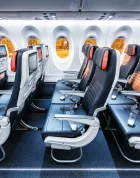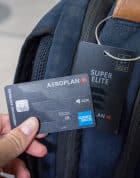Preferred Pricing is an Aeroplan feature that provides discounts on Air Canada flights as you engage more with the program, in which members with Aeroplan Elite Status or a Aeroplan co-branded credit card are rewarded with lower award prices than members without elite status or a credit card.
In this article, we’ll conduct an in-depth analysis on Preferred Pricing to assess the significance of the discounts on award pricing based on your level of engagement with the program (i.e., various levels of elite status and/or credit card ownership).
Methodology
Similar to our previous analysis following the launch of the most recent iteration of Aeroplan in November 2020, we chose a number of Air Canada routes and took samples of the pricing across different routes and dates. In an effort to avoid any fluctuations in prices from dynamic pricing, we conducted the searches within a single day.
For this analysis, we took samples from the following combinations of status level and credit card ownership:
- No status + No credit card
- No status + Core credit card
- Aeroplan 25K + Core credit card (e.g., TD Aeroplan Visa Infinite)
- Aeroplan 50K + Core credit card
- Aeroplan 50K + Premium credit card (e.g., American Express Aeroplan Reserve Card)
- Aeroplan Super Elite + Premium credit card (i.e., in theory the most powerful combination)
From each account, we conducted a search on a range of domestic and international Air Canada routes on four separate dates throughout the year: December 21, March 21, June 21, and September 21.
While the primary purpose of this analysis is looking into Preferred Pricing, we’ll also get some insight into dynamic pricing by sampling throughout the year. However, we’ll save a full discussion of dynamic pricing for a future in-depth analysis.
For each route, we’ll present the data and offer a brief analysis, before looking at broad themes and conclusions across all charts at the end of the article.
For our searches, we used the following criteria:
- Only direct flights with Air Canada were considered, and if a direct flight wasn’t available on any of the dates, the cell is marked with a dash.
- In the event of multiple direct Air Canada flights on a given date (such as Toronto–Montreal), only the cheapest available option was chosen
- The three values in each cell represent Economy (Standard), Economy (Flex), and Economy (Latitude), in that order.
- When calculating the discounts, we’ll only consider the Economy (Standard) fares, for reasons discussed in the analysis.
Note that there were some cases where dynamic pricing affected searches conducted within mere hours of each other. This resulted in one of the tiers having pricing that was inconsistent with the rest of the tiers, and we have simply excluded them with a dash in the below charts.
For the analysis, we’ll focus in on three metrics from the tables:
- The difference between the “No status + No credit card” tier and the “No status + Core card” tier
- The difference between the “No status + Core card” tier and the “Aeroplan 25K + Core card” tier
- The difference between the “No status + No credit card” tier and the “Super Elite + Premium card” tier
The above three values should give us a good idea of how much a difference your engagement with Aeroplan makes for Preferred Pricing between each level.
Lastly, since this discussion only considers the three different Economy fares, we’ll save the discussion of Premium Economy and Business Class fares for a future in-depth analysis of dynamic pricing.
We are grateful to members of the Prince of Travel team, as well as Prince of Travel members, who contributed their time and effort into the searches.
1. Toronto (YYZ) – Montreal (YUL)
December 21, | March 21, | June 21, | September 21, | |
No status | 7.7K | 4.2K | 7.5K | 7.6K |
No status | 7.7K | 3.9K | 5.5K | 5.5K |
Aeroplan 25K | 7.7K | 3.8K | 5.4K | 5.4K |
Aeroplan 50K | 7.7K | 3.7K | 5.3K | 5.3K |
Aeroplan 50K | 7.7K | 3.7K | 5.3K | 5.3K |
Aeroplan SE | 7.7K | 3.7K | 5.3K | 5.3K |
According to the published ranges on the Flight Reward Chart, economy class flights from Toronto–Montreal should cost 6,000–10,000 Aeroplan points most of the time.
Across all date ranges, the Economy (Standard) fare falls within the published range, while the Economy (Flex) and Economy (Latitude) fares are all above the 10,000-point value.
The biggest shift in pricing occurs between a member who doesn’t have status or a credit card and a member with a credit card.
As we move up the tiers, there is a minimal difference in pricing between simply having an Aeroplan credit card and having top-tier Super Elite status and a premium credit card. In most cases, the maximal difference we see is just 200 points.
Two key findings from this chart are as follows:
- There is no difference in pricing on December 21, which could suggest that Preferred Pricing is non-existent during peak travel periods on this route.
- Preferred Pricing appears to cap out once you hit the 50K tier.
To sum up the above chart, we arrive at the following values:
- The average difference between a member without status who doesn’t have a co-branded credit card and a Super Elite with a premium credit card is 23.8%, with a high of 30.2% and a low of 11.9%.
- The average difference a member without status or a co-branded credit card and a member with a co-branded credit card is 20.5%, with a high of 27.6% and a low of 7.1%.
- The average difference between a member without status who has a credit card and a member with both 25K status and a co-branded credit card is 2.1%, with a high of 2.6% and a low of 1.8%.
2. Toronto (YYZ) – Vancouver (YVR)
December 21, | March 21, | June 21, | September 21, | |
No status | 41.1K | 7.4K | 14.6K | 14.6K |
No status | 37.8K | 6.9K | 12.6K | 12.6K |
Aeroplan 25K | - | 6.9K | 11.5K | 11.5K 22.5K 29.5K |
Aeroplan 50K | 36.6K | 6.8K | 11.4K | 11.4K |
Aeroplan 50K | 36.6K | 6.8K | 11.4K | 11.4K |
Aeroplan SE | 36.6K | 6.8K | 11.4K | 11.4K |
According to the published ranges on the Flight Reward Chart, an economy class flight from Toronto–Vancouver should cost 12,500–17,500 Aeroplan points most of the time.
With the exception of the December 21, 2022 pricing, which falls during peak travel season and was sampled a few weeks prior to departure, the Economy (Standard) values all fall within the published range.
The values are actually below the lower end of the range for all members in the March sample, while members with Aeroplan 25K status or greater enjoy pricing just below the threshold in June and September as well.
Once again, we see that Preferred Pricing maxes out at the 50K level, as the prices don’t drop any further once that tier is reached.
The following values sum up some of the key differences in the above chart:
- The average difference between a member without status who doesn’t have a co-branded credit card and a Super Elite with a premium credit card is 15.7%, with a high of 21.9% and a low of 8.1%.
- The average difference a member without status or a co-branded credit card and a member with a co-branded credit card is 10.6%, with a high of 13.7% and a low of 6.8%.
- The average difference between a member without status who has a credit card and a member with both 25K status and a co-branded credit card is 8.7%.
3. Toronto (YYZ) – Punta Cana (PUJ)
December 21, | March 21, | June 21, | September 21, | |
No status | 58.6K | 41.9K | 11.9K | 42.4K |
No status | 55.7K | 38.6K | 11.4K | 39K |
Aeroplan 25K | - | 38K | 11.3K | 38.5K |
Aeroplan 50K | - | 37.4K | 11.3K | 37.9K |
Aeroplan 50K | - | 37.4K | 11.3K | 37.9K |
Aeroplan SE | 55.8K | 37.4K | 11.3K | 37.9K |
According to the published ranges on the Flight Reward Chart, Toronto–Punta Cana in economy class should cost 12,500–17,500 Aeroplan points in most cases.
With the exception of the June numbers, all of the values are well above the published range on this route, including up to almost five times the lowest published value in December. This is a clear example of dynamic pricing not working in your favour, and these cases, it’s best to look for alternative flights on partner airlines.
By this point, another pattern is emerging. The biggest difference lies between the top two rows, whereby simply having an Aeroplan credit card lowers the price by up to 8%, and from there, the difference between not having status and having status further lowers the price by around 1%.
Notable about this chart are the range of values in June. Indeed, the Economy (Standard) prices are all just under the lower end of the dynamic range, but the differences are much less dramatic than the other dates which fall within the dynamic pricing range.
This could suggest that Preferred Pricing differences between tiers are less meaningful when the cost of flights is in the “Saver” range, and more meaningful when they’re outside of the stated range. Let’s keep that in mind as we begin to explore international destinations for the remainder of the analysis.
We arrive at the following numbers gleaned from the above chart:
- The average difference between a member without status who doesn’t have a co-branded credit card and a Super Elite with a premium credit card is 7.8%, with a high of 10.6% and a low of 4.8%.
- The average difference a member without status or a co-branded credit card and a member with a co-branded credit card is 6.3%, with a high of 8% and a low of 4.2%.
- The average difference between a member without status who has a credit card and a member with both 25K status and a co-branded credit card is 1.3%, with a high of 1.6% and a low of 0.9%.
4. Vancouver (YVR) – Tokyo (TYO)
December 21, | March 21, | June 21, | September 21, | |
No status | 180.7K | 100.6K | 35K | 66.4K |
No status | 172.1K | 89.2K | 34.2K | 55.2K |
Aeroplan 25K | 171.9K | 89K | 33.9K | 55.1K |
Aeroplan 50K | 171.6K | - | 33.7K | 54.8K |
Aeroplan 50K | 171.6K | 88.7K | - | 54.8K |
Aeroplan SE | 171.6K | 88.7K | 33.7K | 54.8K |
According to the published ranges on the Flight Reward Chart, an economy class flight from Vancouver–Tokyo should cost 35,000–65,000 Aeroplan points in most cases.
Indeed, the only date that we see values within this range is in June, while all other dates are significantly affected by dynamic pricing. Since Japan has reopened to tourism, Air Canada is likely seeing very healthy demand on this route, resulting in costs of up to five times more than the 35,000-point yardstick.
As we saw on the flights to Punta Cana, the differences between tiers are negligible when the pricing falls within the published range, and are more meaningful as we get into dynamic pricing.
Otherwise, the differences between tiers largely follow the patterns of the above routes, with values as follows:
- The average difference between a member without status who doesn’t have a co-branded credit card and a Super Elite with a premium credit card is 9.5%, with a high of 17% and a low of 4%.
- The average difference a member without status or a co-branded credit card and a member with a co-branded credit card is 8.8%, with a high of 16.9% and a low of 2.3%.
- The average difference between a member without status who has a credit card and a member with both 25K status and a co-branded credit card is 0.36%, with a high of 0.9% and a low of 0.12%.
5. Montreal (YUL) – Paris (CDG)
December 21, | March 21, | June 21, | September 21, | |
No status | - | 33.5K | 51.3K | 42.1K |
No status | - | 32.3K | 42.8K | 41.3K |
Aeroplan 25K | - | 32K | 42.5K | 41K |
Aeroplan 50K | - | 31.8K | 42.3K | 40.8K |
Aeroplan 50K | - | 31.8K | 42.3K | 40.8K |
Aeroplan SE | - | 31.8K | 42.3K | 40.8K |
According to the published ranges on the Flight Reward Chart, Montreal–Paris should cost 35,000–65,000 Aeroplan points in economy class in most cases.
Of note here is that only Economy (Latitude) fares were available during the holiday season in December 2022, representing significant demand on this route for the holidays.
Otherwise, the values for March, June, and September largely fall within the published range, including Economy (Flex) fares in many cases.
Let’s take a look at our key metrics for the route between Montreal and Paris:
- The average difference between a member without status who doesn’t have a co-branded credit card and a Super Elite with a premium credit card is 7.5%, with a high of 17.5% and a low of 3.1%.
- The average difference a member without status or a co-branded credit card and a member with a co-branded credit card is 6.5%, with a high of 16.6% and a low of 1.9%.
- The average difference between a member without status who has a credit card and a member with both 25K status and a co-branded credit card is 0.6%, with a high of 0.9% and a low of 0.1%.
6. Calgary (YYC) – London (LHR)
December 21, | March 21, | June 21, | September 21, | |
No status | 84.7K | 37.9K | 61K | 40K |
No status | 70.7K | 36.4K | 50.8K | 38.7K |
Aeroplan 25K | 70.2K | 35.9K | 50.3K | 38.2K |
Aeroplan 50K | - | 35.4K | - | 37.7K |
Aeroplan 50K | 69.7K | 35.4K | 49.8K | 37.7K |
Aeroplan SE | 69.7K | 35.4K | 49.8K | 37.7K |
According to the published ranges on the Flight Reward Chart, Calgary–London should cost 40,000–70,000 Aeroplan points in economy class most of the time.
The pricing on the Calgary–London route in this sample falls entirely within the range on the March and September dates across all fares, while only some fares from the December and June dates price accordingly.
As we’ve seen previously, there is a lesser difference between tiers on the dates with pricing in the published range than there is on dates with higher prices.
- The average difference between a member without status who doesn’t have a co-branded credit card and a Super Elite with a premium credit card is 12.1%, with a high of 18.4% and a low of 5.8%.
- The average difference a member without status or a co-branded credit card and a member with a co-branded credit card is 10.2%, with a high of 17% and a low of 3.3%.
- The average difference between a member without status who has a credit card and a member with both 25K status and a co-branded credit card is 1.1%, with a high of 1.4% and a low of 0.7%.
7. Toronto (YYZ) – Hong Kong (HKG)
December 21, | March 21, | June 21, | September 21, | |
No status | - | - | 49.4K 83.4K | 49K |
No status | - | - | 48.6K | 48.3K |
Aeroplan 25K | - | - | 47.9K | 47.6K |
Aeroplan 50K | - | - | 47.1K | 46.8K |
Aeroplan 50K | - | - | 47.1K | 46.8K |
Aeroplan SE | - | - | 47.1K | 46.8K |
According to the published ranges on the Flight Reward Chart, flying from Toronto–Hong Kong should cost 50,000–90,000 Aeroplan points in economy class most of the time.
Indeed, the values for June and September all fall within or near the published range across all economy fares.
As we’ve noted before, there isn’t as much of a difference between the tiers in the above chart, as the pricing tends to be consistently low across all dates.
This results in lower discounts from Preferred Pricing than what we’ve seen in the other examples:
- The average difference between a member without status who doesn’t have a co-branded credit card and a Super Elite with a premium credit card is 4.6%, with a high of 4.7% and a low of 4.5%.
- The average difference a member without status or a co-branded credit card and a member with a co-branded credit card is 1.5%, with a high of 1.6% and a low of 1.4%.
- The average difference between a member without status who has a credit card and a member with both 25K status and a co-branded credit card is 1.45%, with a high of 1.5% and a low of 1.4%.
8. Toronto (YYZ) – São Paulo (GRU)
December 21, | March 21, | June 21, | September 21, | |
No status | 79.2K | 39.4K | 70.1K | 39.4K |
No status | 66K | 38.8K | 58.4K | 38.8K |
Aeroplan 25K | 65.3K | 38.1K | 57.7K | 38.1K |
Aeroplan 50K | 64.5K | 37.3K | - | 37.3K |
Aeroplan 50K | 64.5K | 37.3K | 56.9K | 37.3K |
Aeroplan SE | 64.5K | 37.3K | 56.9K | 37.3K |
According to the published ranges on the Flight Reward Chart, Toronto–São Paulo should cost 40,000–70,000 Aeroplan points in economy class most of the time.
The majority of prices across all dates fall within the range, including Economy (Standard), Economy (Flexible), and Economy (Latitude). Throughout the calendar, we don’t see any instances of dramatic dynamic pricing, at least in economy class.
Once again, there’s nothing remarkable that we haven’t already explored in the above routes, aside from noting the lower effects of Preferred Pricing:
- The average difference between a member without status who doesn’t have a co-branded credit card and a Super Elite with a premium credit card is 12%, with a high of 18.8% and a low of 5.3%.
- The average difference a member without status or a co-branded credit card and a member with a co-branded credit card is 9.1%, with a high of 16.7% and a low of 1.5%.
- The average difference between a member without status who has a credit card and a member with both 25K status and a co-branded credit card is 1.5%, with a high of 1.8% and a low of 1.1%.
9. Vancouver (YVR) – Sydney (SYD)
December 21, | March 21, | June 21, | September 21, | |
No status | 131.6K | 93.4K | 93.4K | 97.5K |
No status | 115.3K | 77.9K | 77.9K | 81.3K |
Aeroplan 25K | 114.6K | 77.1K | 77.1K | 80.5K |
Aeroplan 50K | 113.8K | 76.4K | 76.4K | 79.8K |
Aeroplan 50K | 113.8K | 76.4K | 76.4K | 79.8K |
Aeroplan SE | 113.8K | 76.4K | 76.4K | 79.8K |
According to the published ranges on the Flight Reward Chart, Vancouver–Sydney should cost 50,000–90,000 Aeroplan points in economy class most of the time.
For our last route in this analysis, we clearly see dynamic pricing coming into play. It’s worth noting that many of the values for flights in economy are also over the published ranges on this route for both premium economy and business class.
We’ve seen a lot of discussion about Air Canada’s pricing on this route ever since Australia reopened to tourism, and for good reason. In many cases, for the same cost as an Aeroplan booking in Economy (Standard) with Air Canada, you could fly from Vancouver to Australia in business class via Taipei or Tokyo with partner airlines.
Let’s finish up with our reference numbers before diving into a bit of analysis:
- The average difference between a member without status who doesn’t have a co-branded credit card and a Super Elite with a premium credit card is 17%, with a high of 18.2% and a low of 13.5%.
- The average difference a member without status or a co-branded credit card and a member with a co-branded credit card is 15.6%, with a high of 16.6% and a low of 12.4%.
- The average difference between a member without status who has a credit card and a member with both 25K status and a co-branded credit card is 0.9%, with a high of 1% and a low of 0.6%.
How Does Aeroplan Preferred Pricing Work?
When we first conducted an analysis on Preferred Pricing upon the program’s launch in November 2020, we came to the following main conclusions:
- The biggest difference in Preferred Pricing is moving from the “No status + No credit card” tier to the “No status + Core card” tier.
- There wasn’t a meaningful difference in pricing once you either have status or an Aeroplan credit card.
- Once you reach 50K status, the discounts from Preferred Pricing have peaked, and there are no further changes.
As we’ve shown, these conclusions still hold true from the above analysis. By simply holding an Aeroplan co-branded credit card, you’re able to score the biggest advantage from Preferred Pricing, and above that, you only stand to obtain very minimal savings.
This is perhaps a very obvious sign that adding a co-branded Aeroplan credit card to your wallet is a must-do for anyone who engages with the Aeroplan program.
As demonstrated in the dates where the cost tends to be greater than the published range, Preferred Pricing appears to affect routes that enter into the higher range of dynamic pricing more so than routes that fall within the published range.
In these cases, the difference between the “No status + No credit card” and the “50K or above status + Credit card” tiers is the most meaningful, resulting in savings of upwards of 20%.
Overall, there appears to be roughly four different pricing tiers with Aeroplan, which can be described as follows:
- A regular pricing tier for members without status or a credit card, representing the most expensive prices for award bookings
- The first discount tier for members with a credit card or with status, representing a discount of 8–15% from the regular pricing tier
- The second discount tier for members with status and a co-branded credit card, representing a minimal discount of around 1% from the first discount tier
- The third discount tier for members with 50K status or above, representing a further marginal discount from the second discount tier
Let’s again reiterate the the first discount tier is by far the most meaningful, and everything from there on is just in small increments.
Lastly, it’s worth noting that the same discounts we saw with the Economy (Standard) fares don’t appear to apply to Economy (Flex) or Economy (Latitude) fares.
For example, in the Toronto–Montreal chart, we wound up with the following average discounts:
- The average difference between a member without status who doesn’t have a co-branded credit card and a Super Elite with a premium credit card is 23.8%.
- The average difference a member without status or a co-branded credit card and a member with a co-branded credit card is 20.5%.
- The average difference between a member without status who has a credit card and a member with both 25K status and a co-branded credit card is 2.1%.
On the same chart, we get the following average discounts for the Economy (Flex) fares:
- The average difference between a member without status who doesn’t have a co-branded credit card and a Super Elite with a premium credit card is 10.5%.
- The average difference a member without status or a co-branded credit card and a member with a co-branded credit card is 9.4%.
- The average difference between a member without status who has a credit card and a member with both 25K status and a co-branded credit card is 0.7%.
And we get the following average discounts for the Economy (Latitude) fares:
- The average difference between a member without status who doesn’t have a co-branded credit card and a Super Elite with a premium credit card is 7.3%.
- The average difference a member without status or a co-branded credit card and a member with a co-branded credit card is 6.4%.
- The average difference between a member without status who has a credit card and a member with both 25K status and a co-branded credit card is 0.5%.
A similar pattern emerges when looking at the other charts in this sample, which suggests that Preferred Pricing most significantly affects Economy (Standard) pricing. Economy (Flex) fares appear to be more discounted than Economy (Latitude) fares, indicating that Preferred Pricing is less meaningful for these higher Economy fares.
Naturally, it would be worthwhile to compare the discounts for business class and premium economy fares, to see how they stack up compared to the economy pricing patterns we have noticed. Keep an eye out for that analysis in a future discussion of dynamic pricing.
Conclusion
Preferred Pricing affects Air Canada flights booked with Aeroplan points. Generally speaking, you’ll pay more in points if you’re less engaged with the program, and less in points if you’re more engaged with the program.
In keeping with what we learned from the initial analysis of Preferred Pricing in November 2020, the biggest jump comes from showing a minimal amount of engagement with Aeroplan. By simply holding a co-branded credit card, you stand to benefit from the biggest discount on Air Canada flights.
From there, if you earn one of the lower tiers of Aeroplan Elite Status, you’ll save an additional few hundred points per booking. And if you have one of the higher statuses as well as a co-branded credit card, you’ll save another handful of points.
As far as Preferred Pricing is concerned, there isn’t a meaningful difference once you have a co-branded credit card, so the best bet for anyone who books Air Canada flights using Aeroplan points is to add an Aeroplan co-branded card to their portfolio.




















